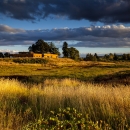States
OregonProject Overview
The refuge’s Rock Creek unit, located along Rock Creek and near Tonquin Road, is an important parcel as part of the larger Rock Creek Floodplain and surrounding forested areas. For the next 3-5 years, the site will undergo active restoration to return to a scrub-shrub wetland; a community of woody shrubs and emergent wetland plants that will be beneficial to a variety of songbirds, marsh birds, reptiles, and amphibians. The refuge has partnered with Clean Water Services on restoration at this site.
Frequently Asked Questions
Why has herbicide spraying occurred at this site?
In order to restore the site to a scrub-shrub wetland (a habitat comprised of shrubs lining a wetland), significant control of invasive species invasive species
An invasive species is any plant or animal that has spread or been introduced into a new area where they are, or could, cause harm to the environment, economy, or human, animal, or plant health. Their unwelcome presence can destroy ecosystems and cost millions of dollars.
Learn more about invasive species needs to occur. The main target of this round of herbicide spray treatment was reed canarygrass, which currently dominates the landscape, preventing native species from growing. In general, invasive species such as reed canarygrass cause environmental harm by displacing native vegetation, altering ecological processes (e.g., hydrology), and degrading the quality of habitats used by wildlife. Due to site conditions, mechanical methods of control, such as mowing, grazing, etc, are not feasible.
What is the impact of herbicide spraying on the current habitat and the species that are there?
Before spraying can occur, herbicide is specifically selected for each site and target species. Each prospective herbicide needs to be approved by U.S. Fish and Wildlife Service (Service), and the refuge consults Service toxicologists and biologists to minimize disturbance. Throughout the herbicide approval process, many environmental factors are considered. Herbicide applicators are beholden to following Service-approved best practices, including spray methodology, and appropriate herbicide dilutions to limit undesired impacts to nontarget and native species. After this initial round of spraying, we will assess the current site conditions to determine future management needs.
What will the site look like in the future?
Projected plans for this scrub-shrub wetland will likely encompass a wetland filled with emergent vegetation, (sedges and rushes, etc), and woody shrubs such as rose spirea and willow that will border the wetland. Habitat types such as these are important to our region and will facilitate habitat favorable to birds like willow flycatcher, American bittern, and common yellowthroat. Further, the mix of shrubs and wetland vegetation will be beneficial habitat to amphibians and reptiles such as the western pond turtle, and northern red-legged frog. While there are birds and other species currently on the landscape, this restoration project will increase the biodiversity of the site, and help return it to a functioning ecosystem that can be enjoyed by a wide variety of species.
What is the timeline for this project?
Non-native vegetation management will go through 2026, with multiple herbicide treatments. Temporarily, the public can expect to see reed canarygrass brown and thin as part of this phase in the restoration process. Following this, native planting and seeding will occur in 2026 and 2027, and the improved habitat will start to take shape.
